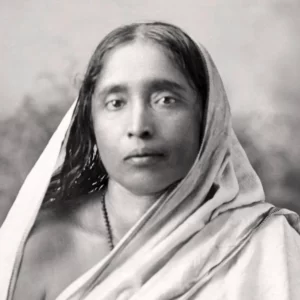 Sarada Devi – called The Holy Mother or Divine Mother – was the consort of Sri Ramakrishna Paramahamsa. To Ramakrishna, Sarada Devi was the visible representation of the Blissful Mother. If they were ‘married as man and wife‘, it was for the purpose of fulfilment of a great Mission, for the purpose of a great religious and spiritual renaissance in the country, and not to live as the ‘normal man and wife’.
Sarada Devi – called The Holy Mother or Divine Mother – was the consort of Sri Ramakrishna Paramahamsa. To Ramakrishna, Sarada Devi was the visible representation of the Blissful Mother. If they were ‘married as man and wife‘, it was for the purpose of fulfilment of a great Mission, for the purpose of a great religious and spiritual renaissance in the country, and not to live as the ‘normal man and wife’.
Divine Mother Sarada Devi
The Consort of Sri Ramakrishna Paramahamsa
An 18 years young maid, Sarada., just came to join her ‘husband’ Ramakrishna, from her far away village, Jayarambati, to Dakshineswar near Calcutta. Ramakrishna was a Priest of the Bhavatarani Ma Temple of Dakshineswar. The girl was putting up with Ramakrishna’s mother in a room a little away, and Ramakrishna was living in a small room by himself.
It was just a few days after the young maid’s arrival that one day Ramakrishna was making his preparations to celebrate the Shodasa Puja for the Goddess Kali. Ramakrishna sends for Sarada. Sarada comes shyly and hesitatingly, hoping she would be asked by her ‘husband to join in the worship. What happens? To her great embarrassment, Ramakrishna asks her and makes her, ‘his wife’, to occupy the seat which he has made and decorated beautifully with flowers, etc. for the “Goddess”. To everyone’s bewilderment, he bows down and prostrates himself at her feet and then begins his worship to her in place of Mother Kali. He did most elaborate worship to her, with flowers and all the customary puja oiferings. At the end of the long and prolonged puja and doing the Aarati (waving of camphor light), he exclaims aloud, “Oh Jaganrnatha! Oh Jagajjananee!” and bows down again to her. Thus at the very threshold of her beginning the housewife’s life itself, the young girl Sarada realised her position and place, in all vividness, in her life to be “with her husband”, something which could never have happened in any womans life ever before.
To Ramakrishna, Sarada Devi was the visible representation of the Blissful Mother. If they were ‘married as man and wife‘, it was for the purpose of fulfilment of a great Mission, for the purpose of a great religious and spiritual renaissance in the country, and not to live as the ‘normal man and wife’. All through their ‘living together’, he worshipped her and censidered her as the Divine Mother Kali Herself alone. And although Sarada Devi too, in her turn adored Ramakrishna as a divine incarnation, yet she had to tend him all the time as a mother tended her child. It was pure spiritual companionship that reigned between them.
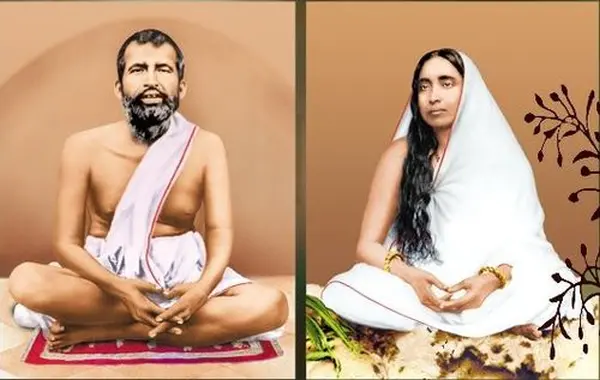
Once when massaging Ramakrishna’s feet, Sarada Devi asked him, “What do you think of me?” Ramakrishna replied at once, “The Mother who is worshipped in the Temple is the Mother who has given birth to this body, and is now living in the concert-room, and she again is massaging my feet at this moment. Verily, I look upon you as the visible representation of the Blissful Mother”. For this strange and astonishing husband, his ‘wife’ is none but the Supreme Goddess. What a unique couple were they!
The only difference between both of them was while Ramakrishna’s love of God was uninhibited and reached ‘the maddest’ proportions and because of which he earned the name of “the mad monk of Dakshineswar”, Sarada Devi on the other hand always carried with her an air of stateliness and dignified serenity. She was a symbol and ideal of India’s womanhood; and marching along close behind and along with her Master – she too attained – along with Him – the acme of spiritual perfection. In their lives, all scriptures of the world find total fulfilment. Blessed indeed is Bharat by the glorious and luminous examples of these great twin-souls. For a woman, life is felt incomplete unless she has a son. Once Ramakrishna told Sarada Devi: “Never think you have no son… In the years to come you will see for yourself that you will not be able to even keep a count of the number of sons you will be having!” True to the Master’s prophetic words, no count is indeed possible of the children that she had – viz., Vivekananda, Brahmananda,… and so on, who all looked to her as their True Mother, always seeking her love and grace. After the Master’s passing away, all looked to her only and sought constant guidance from her in their lives, temporal as well as spiritual. It was Mother Sarada Devi who brightened and kept up the torch alight, the torch of the glorious Indian womanhood coming down from times immemorial, and embellished by the great examples of Mother Sita and the like in the ages yore.
HER LIFE
It was in 1853 on 22nd December that Sarada Devi was born at Jairambati, a small village of Bankura District in Bengal. Her father, Ramachandra Mukherjee was of meagre means, but was a very pious brahmin and an ardent devotee of Sri Rama, ‘Raghubir’. Her mother too was a very pious lady. Though Sarada had not gone to school, but listening to spiritual discourses and scriptural recitals in the village and in her own house, of which her father was fond of, she imbibed the great cultural values and holy traditions of India and especially the glory of Indian womanhood. As she also happened to be the eldest among seven children and that too of a poor family, she had to always help her mother in the domestic chores and tending and looking after her brothers and sisters. All these mellowed her understanding even in childhood, and she was ever soft-spoken, gentle-natured, and always loving and understanding others and their problems.
At the age of five, Sarada was married to Gadadhar of Kamarpukur, later to become known and famous all over the world as Sri Ramakrishna Paramahamsa. Gadadhar was at that time about 24 years, he was thus senior to Sarada by 19 years in age. Before the marriage itself, during a village festival at Shihar, at a village-fair when a drama performance was taking place in which Gadadhar was playing the role of Siva, the child Sarada who came to witness it along with her playmates, it is said, told her friends. pointing to Gadadhar who was in Siva’s role, that he was going to be her future husband. Similarly, when Gadadhar’s mother was looking for a bride in her native village, Gadadhar remarked that a bride had been waiting for him in the home of Shri Ramachandra Mukherjee of Jairambati. Thus the union of Sarada Devi and Ramakrishna was a pre-ordained union, each of them having a fore-knowledge of the mutual and respective roles they would have to play in the divine mission.
Young Sarada was coming from her village to join her husband at Dakshineshwar. It was quite an arduous journey. She had to cross through a forest area infested with dacoits, on the way. It happened that her companions went ahead, while she was lagging behind. She was left alone and she missed her way. It was getting dark. Suddenly one fierce- looking dacoit was seen to be rushing towards her. But she remained undaunted. She said, “Father, I lost my way, I am so afraid, and you have come as a God to save me”. The dacoit’s wife also happened to come there at that moment and she asked Sarada who she was and where she was going. Sarada said, “Mother, I am Sarada, your daughter only. I am on my way to Dakshineshwar to join my husband. Had both of you not come, I cannot imagine what could have happened to me. Oh God is so kind, he sent you both to save and help me”. These sweet and gentle words touched the heart of the wild couple; they took her along with them to their home, offered her food and made her rest and sleep for the night there with them. Next morning, they escorted her up to Tarakeshwar and put her safely on her way to Dakshineshwar. They were so sad as if she was their own daughter leaving them. Such was the power of her love, pure and divine, winning and captivating the hearts of any and every one.
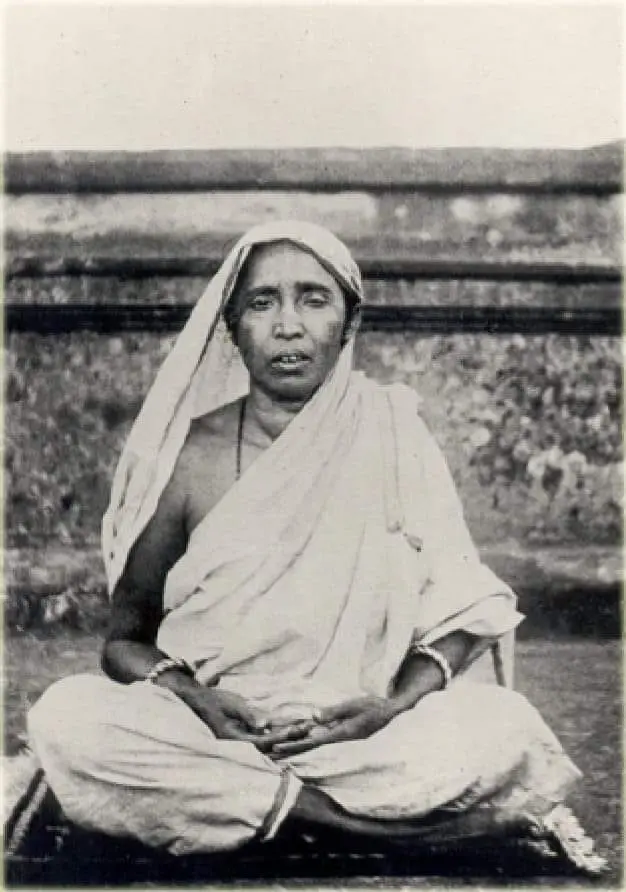
On another occasion also, when she was on her way to Dakshineshwar from her village, she became ill and had to break her journey and rest in a way- side dharmasala. There she had the vision of Mother Kali as a dark complexioned beautiful girl, soothing her fever-stricken body and even talking to her. Next morning she was completely normal and could resume her journey.
In later years again, when Thakur Ramakrishna (Ramakrishna Paramahamsa) was suffering from cancer in his throat and was at Cossipore, the vision of the same Form of Goddess Kali appeared again to Sarada Ma. Her neck looked swollen and was bent sideways. When Sarada Ma asked her what was the matter with her neck, the young girl replied that she was (also) suffering from throat-cancer like the Thakur. It is a divine kinship — of Mother Kali, Sri Ramakrishna and Sri Sarada Devi. The three seem to be one only in reality.
The austere life led by Ma Sarada in Dakshineshwar for so many years, staying in a small room, serving the Master and all the visitors who used to pour in ceaselessly from pre-dawn and into the late night, with a motherly solicitude for all, is indeed a unique example, signifying that service indeed is the highest Sadhana. She was an embodiment of forbearance.
In 1886, on August 16, Sri Ramakrishna took Mahasamadhi. Sarada Ma cried inconsolably why Mother Kali had forsaken her. She broke her bangle: and removed away all her ornaments as per the ‘custom for a Hindu woman when she lost her husband’. As she was doing this, she had a clear and vivid vision of Sri Ramakrishna, telling her that he was not dead, and that his spirit is eternally existent and that he is ever with her and with his devotees. He also told her that she should never forsake her responsibility, she would have to continue the spiritual mission he had started, and should especially guide and look after the numberless disciples and devotees who would be always looking to her as a Mother. She was thereafter experiencing Thakur’s living presence everywhere. Once while she was travelling in the train, lying near the window, she saw Thakur, peeping through the window of the moving train and warning her about the sacred gold amulet which Thakur gave her only a few days before his passing away, and which was being worn by Ma Sarada in the train. Their companionship was perhaps eternal.
Vivekananda and all the disciples of the Master always looked to her for guidance. Vivekananda embarked on his voyage to America to attend the Parliament of Religions only after Mother Sarada Devi gave her permission and blessed him. During her days at Karmarpukur, after Thakur’s passing away, she was in utter poverty but she quietly bore all the hardships in her usual fortitude and serenity, because Ramakrishna used to always tell her that no money was to be accepted from anyone.
It was through the efforts of the disciples of the Master that she was persuaded and brought to Calcutta and lodged in temporary accommodation here and there. In 1908, Swami Saradananda (Sarat Maharaj) built a house for Ma Sarada at Udbhadhan Lane. For eleven years, she stayed there, carrying on the work entrusted to her by the Master and worshipping the Idols of Krishna and Thakur which were enshrined there.
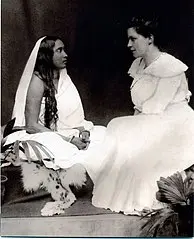
In 1916, Swami Sharadananda built a small mud hut for the Mother at Jairambhati. Swami Japananda (another disciple) was there to look after the needs of the Mother. The floor of the verandah had some sharp brick-pieces lying in here and there, embedded in the floor, and Japananda was hurt by one of them one day during night. As he came out of the room, to his bewilderment he saw the Mother in the verandah with a lantern in one hand, picking up the sharp-edged brick pieces and throwing them away with the other hand, so that they would not hurt anyone again. Such was the compassionate nature of hers. She was indeed an ocean of love which surpassed all boundaries of caste, creed, religion, status and all. Whether a dacoit or monk, whether a Muslim or Hindu, she considered and loved them all as her own children. She used to say, that the Master left her behind only to develop the ideal of Motherhood on Earth.
On July 21, 1920, the Holy Mother left her mortal coil, to join the Master in Eternity. But the Divine couple are ever with us giving spiritual succour to all whosoever looks to them and seek it. Sarada Ma is a symbol of the great womanhood of this sacred country and its richest spiritual heritage.
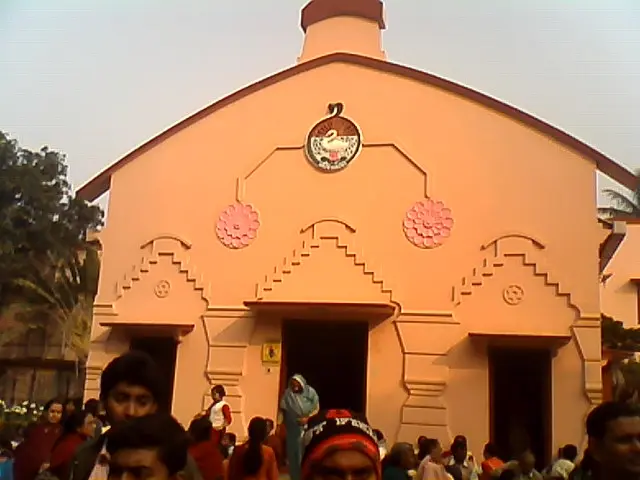
![]()

